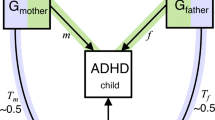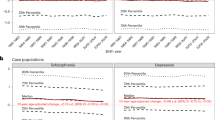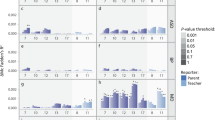Abstract
Children presenting comorbid attention-deficit/hyperactivity disorder (ADHD) and depression symptoms have higher risks of later suicidal ideation and attempt. However, it is unclear to what extent this risk stems from individual differences in the genetic predisposition for ADHD and/or depression. We investigated the unique and combined contribution of genetic predisposition to ADHD and depression to suicidal ideation and attempt by early adulthood. Data were from two longitudinal population-based birth cohorts, the Quebec Longitudinal Study of Child Development and the Quebec Newborn Twin Study (total N = 1207). Genetic predisposition for ADHD and depression were measured using polygenic scores. Suicidal ideation and attempt by age 20 years were self-reported via questionnaires. Across the two cohorts, suicidal ideation and attempt were reported by 99 (8.2%) and 75 (6.1%) individuals, respectively. A higher polygenic score for depression was associated with significantly higher risk of suicidal ideation and attempt, while no significant associations were found for ADHD polygenic score. However, we found an interaction between polygenic scores for depression and ADHD in the association with suicide attempt (P = 0.012), but not suicidal ideation (P = 0.897). The association between polygenic score for depression and suicide attempt was significantly stronger for individuals with a higher polygenic score for ADHD. Individuals scoring ≥ 1-SD above the mean for both polygenic scores were at increased risk for suicide attempt compared to individuals with lower scores (OR 4.03, CI 1.64–9.90), as well as compared to individuals scoring ≥ 1-SD above the mean in only depression (OR 2.92, CI 1.01–8.50) or only ADHD (OR 4.88, CI 1.56–15.26) polygenic scores. Our findings suggest that genetic predisposition for ADHD and depression contributes to increase the risk of suicide attempt in a multiplicative, rather that additive, way. Our results contribute to our understanding of the etiology of suicide risk and may inform screening and risk stratification.
This is a preview of subscription content, access via your institution
Access options
Subscribe to this journal
Receive 12 print issues and online access
$259.00 per year
only $21.58 per issue
Buy this article
- Purchase on SpringerLink
- Instant access to full article PDF
Prices may be subject to local taxes which are calculated during checkout



Similar content being viewed by others
Data availability
Data from the QLSCD are available to authorized researchers via the Centre D’Access aux Données de Recherche de l’Institut de la Statistique du Québec (https://www.jesuisjeserai.stat.gouv.qc.ca). Data from the QNTS are available to authorized researchers via the Groupe de Recherche Sur l’Indaptation Psychosociale chez l’Enfant (https://grip-info.ca).
Code availability
The R code used to generate the results of this study is available upon request.
References
Turecki G, Brent DA. Suicide and suicidal behaviour. Lancet Lond Engl. 2016;387:1227–39.
Leo DD, Goodfellow B, Silverman M, Berman A, Mann J, Arensman E, et al. International study of definitions of English-language terms for suicidal behaviours: a survey exploring preferred terminology. BMJ Open. 2021;11:e043409.
Orri M, Scardena S, Perret LC, Bolanis D, Temcheff C, Séguin JR, et al. Mental health problems and risk of suicidal ideation and attempts in adolescents. Pediatrics. 2020;146:e20193823.
Nock MK, Green JG, Hwang I, McLaughlin KA, Sampson NA, Zaslavsky AM, et al. Prevalence, correlates, and treatment of lifetime suicidal behavior among adolescents: results from the national comorbidity survey replication adolescent supplement. JAMA Psychiatry. 2013;70:300–10.
Tidemalm D, Långström N, Lichtenstein P, Runeson B. Risk of suicide after suicide attempt according to coexisting psychiatric disorder: Swedish cohort study with long term follow-up. BMJ. 2008;337:a2205.
Orri M, Vergunst F, Turecki G, Galera C, Latimer E, Bouchard S, et al. Long-term economic and social outcomes of youth suicide attempts. Br J Psychiatry. 2021;16:1–7.
Goldman-Mellor SJ, Caspi A, Harrington H, Hogan S, Nada-Raja S, Poulton R, et al. Suicide attempt in young people: a signal for long-term health care and social needs. JAMA Psychiatry. 2014;71:119–27.
Docherty AR, Mullins N, Ashley-Koch AE, Qin X, Coleman JRI, Shabalin A, et al. GWAS meta-analysis of suicide attempt: identification of 12 genome-wide significant loci and implication of genetic risks for specific health factors. Am J Psychiatry. 2023;180:723–38.
DiBlasi E, Kang J, Docherty AR. Genetic contributions to suicidal thoughts and behaviors. Psychol Med. 2021;51:2148–55.
Mullins N, Kang J, Campos AI, Coleman JRI, Edwards AC, Galfalvy H, et al. Dissecting the shared genetic architecture of suicide attempt, psychiatric disorders, and known risk factors. Biol Psychiatry. 2022;91:313–27.
Huang K-L, Wei H-T, Hsu J-W, Bai Y-M, Su T-P, Li C-T, et al. Risk of suicide attempts in adolescents and young adults with attention-deficit hyperactivity disorder: a nationwide longitudinal study. Br J Psychiatry. 2018;212:234–8.
Forte A, Orri M, Galera C, Pompili M, Turecki G, Boivin M, et al. Developmental trajectories of childhood symptoms of hyperactivity/inattention and suicidal behavior during adolescence. Eur Child Adolesc Psychiatry. 2020;29:145–51.
Garas P, Balazs J. Long-term suicide risk of children and adolescents with attention deficit and hyperactivity disorder—a systematic review. Front Psychiatry. 2020;11:557909.
Septier M, Stordeur C, Zhang J, Delorme R, Cortese S. Association between suicidal spectrum behaviors and attention-deficit/hyperactivity disorder: a systematic review and meta-analysis. Neurosci Biobehav Rev. 2019;103:109–18.
Gvion Y, Levi-Belz Y, Hadlaczky G, Apter A. On the role of impulsivity and decision-making in suicidal behavior. World J Psychiatry. 2015;5:255.
Posner J, Polanczyk GV, Sonuga-Barke E. Attention-deficit hyperactivity disorder. The Lancet. 2020;395:450–62.
Kim JH, Kim JY, Lee J, Jeong GH, Lee E, Lee S, et al. Environmental risk factors, protective factors, and peripheral biomarkers for ADHD: an umbrella review. Lancet Psychiatry. 2020;7:955–70.
Orri M, Gunnell D, Richard-Devantoy S, Bolanis D, Boruff J, Turecki G, et al. In-utero and perinatal influences on suicide risk: a systematic review and meta-analysis. Lancet Psychiatry. 2019;6:477–92.
Lim KX, Rijsdijk F, Hagenaars SP, Socrates A, Choi SW, Coleman JRI, et al. Studying individual risk factors for self-harm in the UK biobank: a polygenic scoring and mendelian randomisation study. PLoS Med. 2020;17:e1003137.
Otsuka I, Galfalvy H, Guo J, Akiyama M, Rujescu D, Turecki G, et al. Mapping the genetic architecture of suicide attempt and suicide death using polygenic risk scores for clinically-related psychiatric disorders and traits. Psychol Med. 2023;53:2689–97.
Mullins N, Bigdeli TB, Børglum AD, Coleman JRI, Demontis D, Mehta D, et al. GWAS of suicide attempt in psychiatric disorders and association with major depression polygenic risk scores. Am J Psychiatry. 2019;176:651–60.
Sudre G, Frederick J, Sharp W, Ishii-Takahashi A, Mangalmurti A, Choudhury S, et al. Mapping associations between polygenic risks for childhood neuropsychiatric disorders, symptoms of attention deficit hyperactivity disorder, cognition, and the brain. Mol Psychiatry. 2020;25:2482–92.
Gnanavel S, Sharma P, Kaushal P, Hussain S. Attention deficit hyperactivity disorder and comorbidity: a review of literature. World J Clin Cases. 2019;7:2420–6.
Meinzer MC, Pettit JW, Viswesvaran C. The co-occurrence of attention-deficit/hyperactivity disorder and unipolar depression in children and adolescents: a meta-analytic review. Clin Psychol Rev. 2014;34:595–607.
Cuffe S, Visser S, Holbrook JR, Danielson M, Geryk LL, Wolraich M, et al. ADHD and psychiatric comorbidity: functional outcomes in a school-based sample of children. J Atten Disord. 2020;24:1345–54.
Spencer T. ADHD and comorbidity in childhood. J Clin Psychiatry. 2006;67:27–31.
Yoshimasu K, Barbaresi W, Colligan R, Voigt R, Killian J, Weaver A, et al. Psychiatric comorbidities modify the association between childhood ADHD and risk for suicidality: a population-based longitudinal study. J Atten Disord. 2019;23:777–86.
Forte A, Sarubbi S, Orri M, Erbuto D, Pompili M. ADHD symptoms and suicide attempts in adults with mood disorders: an observational naturalistic study. J Affect Disord Rep. 2021;6:100224.
Orri M, Galera C, Turecki G, Forte A, Renaud J, Boivin M, et al. Association of childhood irritability and depressive/anxious mood profiles with adolescent suicidal ideation and attempts. JAMA Psychiatry. 2018;75:465–73.
Kerr DCR, Reinke WM, Eddy JM. Trajectories of depressive symptoms and externalizing behaviors across adolescence: associations with histories of suicide attempt and ideation in early adulthood. Suicide Life Threat Behav. 2013;43:50–66.
Brezo J, Barker ED, Paris J, Hébert M, Vitaro F, Tremblay RE, et al. Childhood trajectories of anxiousness and disruptiveness as predictors of suicide attempts. Arch Pediatr Adolesc Med. 2008;162:1015–21.
Sourander A, Klomek AB, Niemelä S, Haavisto A, Gyllenberg D, Helenius H, et al. Childhood predictors of completed and severe suicide attempts: findings from the Finnish 1981 Birth Cohort Study. Arch Gen Psychiatry. 2009;66:398–406.
Sokolowski M, Wasserman J, Wasserman D. Polygenic associations of neurodevelopmental genes in suicide attempt. Mol Psychiatry. 2016;21:1381–90.
Patros CHG, Hudec KL, Alderson RM, Kasper LJ, Davidson C, Wingate LR. Symptoms of attention-deficit/hyperactivity disorder (ADHD) moderate suicidal behaviors in college students with depressed mood. J Clin Psychol. 2013;69:980–93.
Klonsky ED, May AM, Saffer BY. Suicide, suicide attempts, and suicidal ideation. Annu Rev Clin Psychol. 2016;12:307–30.
Orri M, Boivin M, Chen C, Ahun MN, Geoffroy M-C, Ouellet-Morin I, et al. Cohort profile: quebec longitudinal study of child development (QLSCD). Soc Psychiatry Psychiatr Epidemiol. 2021;56:883–94.
Boivin M, Brendgen M, Dionne G, Ouellet-Morin I, Dubois L, Pérusse D, et al. The Quebec newborn twin study at 21. Twin Res Hum Genet. 2019;22:475–81.
Forget-Dubois N, Pérusse D, Turecki G, Girard A, Billette J-M, Rouleau G, et al. Diagnosing zygosity in infant twins: physical similarity, genotyping, and chorionicity. Twin Res Hum Genet. 2003;6:479–85.
Paquin S, Lacourse E, Brendgen M, Vitaro F, Dionne G, Tremblay RE, et al. Heterogeneity in the development of proactive and reactive aggression in childhood: common and specific genetic - environmental factors. PLoS ONE. 2017;12:e0188730.
Morneau-Vaillancourt G, Andlauer TFM, Ouellet-Morin I, Paquin S, Brendgen MR, Vitaro F, et al. Polygenic scores differentially predict developmental trajectories of subtypes of social withdrawal in childhood. J Child Psychol Psychiatry. 2021;62:1320–9.
Demontis D, Walters RK, Martin J, Mattheisen M, Als TD, Agerbo E, et al. Discovery of the first genome-wide significant risk loci for attention deficit/hyperactivity disorder. Nat Genet. 2019;51:63.
Howard DM, Adams MJ, Clarke T-K, Hafferty JD, Gibson J, Shirali M, et al. Genome-wide meta-analysis of depression identifies 102 independent variants and highlights the importance of the prefrontal brain regions. Nat Neurosci. 2019;22:343–52.
Ge T, Chen C-Y, Ni Y, Feng Y-CA, Smoller JW. Polygenic prediction via bayesian regression and continuous shrinkage priors. Nat Commun. 2019;10:1776.
Ni G, Zeng J, Revez JA, Wang Y, Zheng Z, Ge T, et al. A comparison of ten polygenic score methods for psychiatric disorders applied across multiple cohorts. Biol Psychiatry. 2021;90:611–20.
Lee SH, Goddard ME, Wray NR, Visscher PM. A better coefficient of determination for genetic profile analysis. Genet Epidemiol. 2012;36:214–24.
Commisso M, Temcheff C, Orri M, Poirier M, Lau M, Côté S, et al. Childhood externalizing, internalizing and comorbid problems: distinguishing young adults who think about suicide from those who attempt suicide. Psychol Med. 2023;53:1030–7.
Solmi M, Radua J, Olivola M, Croce E, Soardo L, Salazar de Pablo G, et al. Age at onset of mental disorders worldwide: large-scale meta-analysis of 192 epidemiological studies. Mol Psychiatry. 2022;27:281–95.
Pompili M. On mental pain and suicide risk in modern psychiatry. Ann Gen Psychiatry. 2024;23:6.
O’Connor RC, Kirtley OJ. The integrated motivational–volitional model of suicidal behaviour. Philos Trans R Soc Lond B Biol Sci. 2018;373:20170268.
Klonsky ED, Saffer BY, Bryan CJ. Ideation-to-action theories of suicide: a conceptual and empirical update. Curr Opin Psychol. 2018;22:38–43.
Bari A, Robbins TW. Inhibition and impulsivity: behavioral and neural basis of response control. Prog Neurobiol. 2013;108:44–79.
Sastre-Buades A, Alacreu-Crespo A, Courtet P, Baca-Garcia E, Barrigon ML. Decision-making in suicidal behavior: a systematic review and meta-analysis. Neurosci Biobehav Rev. 2021;131:642–62.
Dudbridge F. Power and predictive accuracy of polygenic risk scores. PLoS Genet. 2013;9:e1003348.
Lewinsohn PM, Seeley JR, Roberts RE, Allen NB. Center for epidemiologic studies depression scale (CES-D) as a screening instrument for depression among community-residing older adults. Psychol Aging. 1997;12:277–87.
Dunn L, Thériault-Whalen C, Dunn L. EVIP: échelle de vocabulaire en images Peabody. Toronto, Canada: Psycan; 1993.
Collet OA, Orri M, Tremblay RE, Boivin M, Côté SM. Psychometric properties of the social behavior questionnaire (SBQ) in a longitudinal population-based sample. Int J Behav Dev. 2023;47:180–9.
Acknowledgements
Drs. Orri, Turecki, Geoffroy, Ouellet-Morin, and Boivin are supported by the Canada Research Chair program. Dr. Orri is supported by an American Foundation for Suicide Prevention Young Investigator Award. Dr Morneau-Vaillancourt is supported by a Banting postdoctoral fellowship from the Social Sciences and Humanities Research Council (510174). Samuele Cortese, NIHR Research Professor (NIHR303122) is funded by the NIHR for this research project. The views expressed in this publication are those of the author(s) and not necessarily those of the NIHR, NHS or the UK Department of Health and Social Care. Samuele Cortese is also supported by NIHR grants NIHR203684, NIHR203035, NIHR130077, NIHR128472, RP-PG-0618-20003 and by grant 101095568-HORIZONHLTH- 2022-DISEASE-07-03 from the European Research Executive Agency. This study was supported by Fonds de Recherche du Québec en Santé (FRQS) via the Québec Network on Suicide, Mood Disorders, and Related Disorders as well as by the Canada Research Chairs of Dr. Boivin and Dr. Gouin. The Québec Longitudinal Study of Child Development was supported by funding from the Ministère de la Santé et des Services sociaux, the Ministère de la Famille, the Ministère de l’Éducation et de l’Enseignement supérieur, the Lucie and André Chagnon Foundation, the Institut de recherche Robert-Sauvé en santé et en sécurité du travail, the Research Centre of the Sainte-Justine University Hospital, the Ministère du Travail, de l’Emploi et de la Solidarité sociale and the Institut de la statistique du Québec. Additional funding was received by the Fonds de Recherche du Québec - Santé (FRQS), the Fonds de Recherche du Québec - Société et Culture (FRQSC), the Social Science and Humanities Research Council of Canada (SSHRC), and the Canadian Institutes of Health Research (CIHR). Funding for the primary school data collections of the Quebec Newborn Twin Study comes from Social Science and Humanities Research Council (SSHRC) grant 410-2001-1475. Funding for the age 20 data collection comes from SSHRC grant 435-2014-1536. The sponsors have no role in study design, data analysis and interpretation, and decision to submit for publication. The authors gratefully acknowledge the ongoing contribution of families, children, and teachers in the QLSCD and QNTS. They also thank Héléne Paradis for QNTS data preparation.
Author information
Authors and Affiliations
Contributions
Dr. Orri conceptualised the study, wrote the initial draft, conducted the statistical analyses. Dr. Voronin and Paquin contributed to data analysis (polygenic scores). All authors contributed to data interpretation and drafting of the final manuscript. Dr. Orri had full access to all the data in the study and takes responsibility for the integrity of the data and the accuracy of the data analysis.
Corresponding author
Ethics declarations
Competing interests
Prof. Cortese has declared reimbursement for travel and accommodation expenses from the Association for Child and Adolescent Central Health (ACAMH) in relation to lectures delivered for ACAMH, the Canadian AADHD Alliance Resource, the British Association of Psychopharmacology, and from Healthcare Convention for educational activity on ADHD, and has received honoraria from Medice. The other authors have no conflict of interest to disclose.
Additional information
Publisher’s note Springer Nature remains neutral with regard to jurisdictional claims in published maps and institutional affiliations.
Supplementary information
Rights and permissions
Springer Nature or its licensor (e.g. a society or other partner) holds exclusive rights to this article under a publishing agreement with the author(s) or other rightsholder(s); author self-archiving of the accepted manuscript version of this article is solely governed by the terms of such publishing agreement and applicable law.
About this article
Cite this article
Orri, M., Morneau-Vaillancourt, G., Ouellet-Morin, I. et al. Joint contribution of polygenic scores for depression and attention-deficit/hyperactivity disorder to youth suicidal ideation and attempt. Mol Psychiatry 30, 4085–4093 (2025). https://doi.org/10.1038/s41380-025-02989-z
Received:
Revised:
Accepted:
Published:
Issue date:
DOI: https://doi.org/10.1038/s41380-025-02989-z



